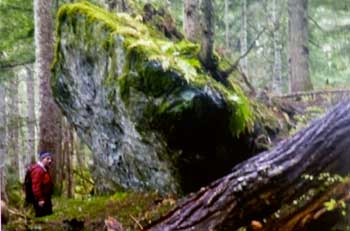Enbridge made its strongest public case yet Tuesday, March 13, that improvements in marine safety worldwide since the Exxon Valdez disaster in 1989, make the chances of an accident involving ships carrying bitumen and condensate in Douglas Channel and the BC Coast highly unlikely.
But one of Enbridge’s own invited experts somewhat undermined the case by pointing out that in the event of a major tanker incident (as unlikely as Enbridge believes it may be) the resources of the federal and provincial governments are spread far too thin to deal with a major disaster.
The Enbridge Community Advisory Board held a public meeting Tuesday at Mt. Elizabeth Theatre, with three guests presenting a case that they also gave to the regular meeting of the advisory board earlier in the day.
The three guests were Capt. Stephen Brown, of the BC Chamber of Shipping, Capt. Fred Denning, of British Columbia Coast Pilots and Norm Fallows, an emergency response officer with the BC Ministry of the Environment, based in Smithers.
There were only a few dozen people in the theatre for the presentation, compared the full house for last year’s community forum that was sponsored by the District of Kitimat. One reason may be that many Kitimat residents preferred being in the stands for the Coy Cup hockey championships at Tamitik Arena rather than sitting through yet another presentation on the Northern Gateway pipeline.
Denning opened the presentations by explaining the role of the BC Coast Pilots. The BC Coast Pilots is a private firm that contracts with government’s Pacific Pilotage Authority to provide pilots to ships plying the coast of British Columbia. By law all vessels larger than 350 gross registered tonnes are required to use a marine pilot.
Both in his presentation and in the question and answer period, Denning stressed that pilots are traditionally independent from government and industry, with the responsibility to ensure the safety of shipping.
In the question and answer period, when an audience member pointed out that under the Transport Canada TERMPOL process, use of tugs in Douglas Channel and use of tethered tugs was “voluntary,” Denning replied that the pilots would be insisting on tethered escort tugs for tankers on Douglas Channel.
He explained that BC pilots are highly experienced mariners, usually with 25 years or more experience on the coast, the majority of that time as a ship’s officer. An applicant to become a pilot is put on a waiting list, and if accepted, then is trained both on ships and simulators and serves a six to 12 month apprenticeship.
He said that BC coastal pilots have a 99.89 per cent incident safety record.
BC pilots now carry a large laptop called a Portable Pilot Unit, which operates independent of the ship’s navigation and computer systems gathering navigation and other data, as a redundant safety system.
Denning expects that marine traffic on the BC coast will continue to increase because the ports of Vancouver and Prince Rupert are the closest to Asia by the Great Circle routes. Both cargo and the energy projects, whether the Enbridge Northern Gateway or the the liquified natural gas terminals will mean more ships and more work for the pilots.
The pilots are always consulted in the development of any new traffic or terminal projects in BC. Including design, testing the ship’s courses in simulators, recommending new navigational aides and training for the pilots. Pilots were consulted during the development of Deltaport and Fairiew container terminals as well as the cruise ship terminals in Victoria, Nanaimo and Campbell River.
The pilots are being consulted on both the Enbridge and LNG projects at Kitimat as well as the proposed expansion of the Kinder Morgan facility in Vancouver. For the existing Kinder Morgan terminal, pilots were involved in creating navigation aides and tug procedures for the Second Narrows.
Stephen Brown is a member of the Community Advisory Board as well as representing the Bureau of Shipping. He began with a detailed timeline of how shipping regulations have been tightened over the years since what is now the International Maritime Organization, a United Nations agency, was founded in 1948. He said the Exxon Valdez accident in 1989 triggered even tighter regulations, including the 1990 US Oil Pollution Act passed by Congress which required all ships have containment capability and a spill clean up plan. The act also ordered US shippers to phase out single hulled tankers beginning in 1995. In 1992, the IMO adopted a similar measure.
Since the 1990s, there have been new regulations preventing the dumping of ballast and creating higher standards for crew and officer training, including hours of work, watch keeping standards and environmental awareness.
Brown then went on to discuss shipping in narrow waterways which he said were similar to Douglas Channel, including the Straits of Dover between Britain and France, the Straits of Malacca between Singapore and Malaysia and the island of Sumatra, the Dardanelles and Bosporus Strait in Turkey (which traditionally are said to join Europe with Asia) and the Panama Canal. All those areas, he said, see heavy shipping traffic, including tankers, each year.
The narrowest passage is in the Bosporus, which is 698 metres wide, a little less than one half nautical mile.
Comparing the Bosporus with Douglas Channel, Brown said Douglas Channel is much wider, about three kilometres, meaning that inbound and outbound ships can pass a half kilometre apart.
He went over how tanker management has improved with double hulls and better overall construction standards,vetting of ships and crews, and creating “a culture of safety and respect for the environment.”
The final speaker Norm Fallows, from the BC Ministry of the Environment Emergency Management, outlined the current emergency response system in the province. Central to any response to a oil spill or any other hazard materials problem is the “incident command system.” also used most often for fighting forest fires. The incident command system ensures that all public agencies and the private sector are cooperating and coordinating with one overall person in charge.
The province has a “polluter pay” policy, Fallows said, meaning that the “responsible party” must pay for all the cost involved. Sometimes, int he case of a meth lab, it is the unfortunate owner of a house that may have been rented by drug dealers.
Fallows said he is one of only 10 emergency response officers stationed across the province of British Columbia, In contrast, the State of Washington, with a much smaller land area than BC, has 79.
Any response to a spill has to do the best possible in the situation, Fallows said. He gave the example of burning off an oil spill in some circumstances because that was both the most cost effective solution that at the same time in those circumstances did the least harm to the environment.
In the early part of the first decade, Fallows said, some staff at the environment department were proposing what was called “Geographic Response Planning,” which involved surveying an area for both potential hazards and solutions, and bringing in local responders including fire, police and local industry. Planning for the GRP program had minimal funding, which was later dropped by the province.
In contrast, Fallows said, the state of Washington has spent millions of dollars creating a geographic response program for that state.
In response to questions from the audience, Fallows said that adequate emergency response in British Columbia needed “more resources” from both the provincial and federal governments.















